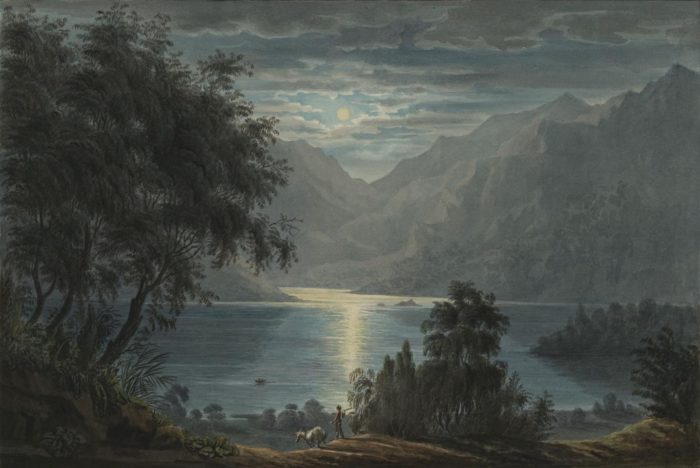
[The epic continues! Read part I of Johan’s journey here and listen for yourself via this playlist]
While working with what was intended to be the second part of a tripartite article series covering the history and general properties of the power metal subgenre, it soon became clear that a sufficiently thorough treatment of the subject would require more space and time than what was originally intended. This insight subsequently led to the conclusion that individual parts needed to be subdivided and portioned out in order to not grow out of proportion. The initial plan to present the material into three consecutive parts has thus been revised.
Another related issue that arose during “research” concerns the historical development of European power metal. As have been noted in previous articles on this site relating to the history of metal music, artistic “movements” or periods of development tend last about five years speaking in generalized terms. This phenomenon can be observed in European power metal as well. After having studied Euro-power metal as a composite phenomenon, a rough sketch outlining the developmental trajectory of said music began to take form:
1984-1989: The first wave of European power metal.
1990-1995: Intermediate period.
1996-2001: The second wave of European power metal.
While not a perfect model, this rough periodic division will be used as a framework for discussion in the articles to follow. The relatively lengthy timespan that has passed since the putatively defined second wave of European power metal will be left out for the moment, primarily (and regrettably) because there hasn’t really occurred much of a development in power metal since the early 2000s. If anyone sits on information that invalidates the above statement, feel free to chip in – this writer would be very pleased to be proven wrong on this front.
Accordingly, the second part of this article series will be mainly devoted to the development and characteristics of the first wave of European power metal and the intermediate period that followed in its wake. Instead of approaching the subject in thoroughly generalized manner, a ???-track compilation will be used as source material to make observations about the historical development and specific traits of first wave Euro-styled power metal. Please not that this collection of tracks is by no means intended as a “best of”-compilation but should rather be viewed of as a springboard for further discussion.
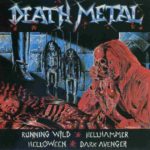 Helloween – “Metal Invaders” from Death Metal (1984) [split compilation]
Helloween – “Metal Invaders” from Death Metal (1984) [split compilation]
In Europe, power metal showed its first signs of life no later than 1984 on German ground, with Noise Record’s infamous (and misfortunately titled) Death Metal sampler serving as a landmark release. Featuring fresh demo material by the Ur-fathers of European power metal Helloween and Running Wild alongside Hellhammer and the by now completely forgotten heavy metal act Dark Avenger, the Death Metal-sampler sparked enough public interest to earn each of the participating bands (except Dark Avenger, presumably) a record deal – a big thing back in the day and a crucial event for kicking off the first wave of European power metal. Judging from these early recordings, Running Wild was still in the process of finding their identity, sounding like a punkier and more primitive version of 1980s Judas Priest. Helloween’s two tracks on the other hand display a band struggling with the rudiments of a formula that would eventually come to influence countless of power metal acts. As such, Helloween’s contribution to the Death Metal-sampler might well be viewed of as a point-zero for European power metal. However, this recording session was soon to be overshadowed by the band’s self-titled mini-LP.
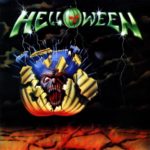 Helloween – “Starlight” from Helloween (1985)
Helloween – “Starlight” from Helloween (1985)
Released less than six months after the aforementioned Noise-compilation, Helloween documents the birth of a characteristically European form of power metal. In a way, the Helloween mini-LP is the Black Sabbath (1970) of power metal in terms of influential status (within its field) and overall character. While Helloween can in no way compete with Black Sabbath when it comes to longstanding influential magnitude, it nonetheless served a pivotal role in spawning a new form of metal music. Another characteristic shared between the albums is that, while containing traces of past musical atavisms, both present a vision strong enough to transcend historical context.
Whereas Black Sabbath sprung out of late 1960s blues/heavy rock/psychedelic/progressive milieu, the early music of Helloween was heavily informed by contemporary developments in 1980s metal. At the time, the NWOBHM had exerted an enormous impact on the global metal community – with bands like Iron Maiden, Def Leppard and Saxon filling stadiums worldwide – but was starting to lose its momentum. Meanwhile, speed metal was clearly on the rise on both sides of the Atlantic; spearheaded in the US by bands like Metallica, Exodus and Slayer, and on European ground primarily by German acts such as Destruction, Kreator and Sodom. Helloween and co. took cues from both of the aforementioned movements and is thus best described as a conglomerate subgenre bringing speed metal techniques into a heavy metal framework.
The tendency of merging contemporary speed- and heavy metal is evident right from the very first song on Helloween. Presumably inspired by the intro to Accept’s proto-speed metal classic “Fast as a Shark”, “Starlight” opens with a sound collage consisting of a man waking up, enjoying his first beer of the day and eventually turning on the radio just in time to catch the ominous commercial from Halloween 3: Season of the Witch, after which an Udo Dirkschneider-like scream fills the speakers. The song proper opens with a rocking riff and chord progression more at home on a contemporary stadium metal album, accompanied by vocals declaring “Alright!” in typical rock-mannerist approval. When the verse eventually kicks in however, pace is increased and the guitars engage in a blistering dual-harmony workout backed up by D-beat-like percussion. The chorus-section ups the ante further in terms of intensity, with typical speed metal palm-muted riffing and double-bass percussion.
Judging from this rather superficial summary of musical events, why not just call it speed metal-influenced heavy metal or vice-versa? What ultimately makes Helloween and similar bands of the era stand out as separate musical entities when compared to contemporary heavy metal is their handling of melody and the intensity of the music. Early power metal reaches for speed metal-levels of intensity and this extends to the field of melody of well. Each composition on the Helloween mini-LP is like a minor melodic deluge and where heavy metals band would normally settle with repeating phrases, Helloween offers a constant stream of melodic variations divided between vocalist, guitars and bass guitar.
It could also be argued that Helloween’s approach to melody differs qualitatively from both heavy- and speed metal. For example, sections dominated by more intense, palm-muted single note riffs doesn’t really sound like speed metal. Helloween put considerably less emphasis on percussive accents, opting instead for a more fluid approach where pedal point rhythm riffing is complimented by “flowing” counter-melodies performed by the second guitarist, while still retaining the punkish rawness of speed metal. Moreover, Helloween aren’t afraid to shift between minor- and major key-based riffs and melodies, which graces the material with a distinct melodic character and sense of dynamics.
In their merging of raw intensity and speed metal-techniques such as palm muting with a more refined sense of melody received through the NWOBHM, the music of early power metal bands like Helloween gained a characteristically uplifting character which has come to be closely associated with the subgenre ever since. This is important, because it tells us something about the inner workings, or spirit if you will, of power metal. Ever since the genre’s conception in the hands of Black Sabbath, metal bands have sought to convey a sense of overwhelming power in various forms, urging the listener to re-connect with primordial forces operating beyond the domain of human control. This process of canalization has taken on different forms throughout the history of the genre; ranging from celebration of monumental force to more direct confrontation with emotions or conceptions habitually shunned by civilized society (fear, hatred, horror, death, etc.). Power metal bands on the other hand seek to evoke forces internal to man: the power of will as a source of empowerment and ascendance, habitually draped in fantastical imagery and lyrical themes dealing with various kinds of ordeals (adventures, quests, etc.)
Although “Starlight” is probably the weakest track on the album (the second song, “Murderer” takes on a similar approach but bypasses the opening track on every front), it nonetheless provides interesting remarks on the conception of European-styled power metal. As can be glimpsed from the brief summary above, “Starlight” utilize elements of speed metal (intensity, speed, playing techniques, etc.) in a structural and stylistic framework reminiscent NWOBHM-influenced heavy metal. However, the end result somehow exceeds the sum of its constituent parts. This is why Helloween and likeminded bands are labelled as power metal rather than “just” speed metal-influenced heavy metal. It’s not so much the combination of speed and heavy metal in itself that calls for the creation of power metal, but how they do it and how this approach in turn affects the expressive content of the music.
Even though the exact birth point of European power metal remains subject to debate, few would question the impact of Helloween in the formation of a generical style and ethos. Arguably one of the earliest cultivators of European power metal and definitely the band to first popularize the style, Helloween paved the way for future generations on a string of highly influential releases during the mid-to-late 1980s. Their ensuing commercial success notwithstanding, Helloween remains as the band’s finest work and is mandatory listening to anyone with the slightest interest in genuine power metal.
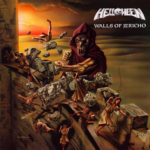 Helloween – ”Ride the Sky” from Walls of Jericho (1985)
Helloween – ”Ride the Sky” from Walls of Jericho (1985)
Walls of Jericho was in many ways a step down from Helloween’s self-titled debut released the same year, plagued by some obvious filler material and slightly less inspired song writing. However, it did feature what would become one of the band’s staple classics – “Ride the Sky” – which comes across as significantly faster and more focused compared to the concurrent material.
Forming the backbone of the composition is an unrelenting yet infectiously melodic twin-guitar attack set to a driving drum beat that, while sticking to basic patterns, display a keen sense of accent. The guitars epitomize the power metal approach of blending speed metal-strumming techniques and NWOBHM-like dual harmonies; alternating between cascading torrents of palm-muted lower E-string pedal tones, melodic inflections built from a handful of power chords in the vein of early
Teutonic speed metal, and longer sequences of Maiden-esque single-note harmonic interplay. A surprisingly freewheeling bass guitar supply roots and the occasional counter melody – a welcome addition that would have benefited from a more suitable tone/mixing. On top of it all surges the human voice, raw, passionate and carrying a sense of sincerity often lacking in later, more polished works by this band and others of their ilk.
Structurally, “Ride the Sky” resembles popular music in the way verses builds up to a grand reductionist chorus. A common feature of power metal ever since, this approach generally limits the scope and longevity of a given composition, but it works here because Helloween manage to sustain momentum over several repetitions through careful variation of given parameters. Each cycle induces a heightened sense of urgency, which is brought to climax during a blistering instrumental section right before the final recapitulation of the chorus. The inevitable sense of propulsion exhibited throughout the track is matched by an unabashedly anthemic and uplifting spiritedness partly derived from the band’s employment of the mixolydian mode (also found in some of Iron Maiden’s “happier” songs such as “Run to the Hills” and “The Number of the Beast”). Thus, a strong link is established between the musical and lyrical content centered around the ever-popular power metal trope of liberation from (supposedly mental) bondage. If there ever was a point where European power metal found its strongest voice, it would be here.
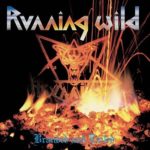 Running Wild – “Mordor” from Branded and Exiled (1985)
Running Wild – “Mordor” from Branded and Exiled (1985)
Another prominent member of the mid-80s German metal scene, Running Wild gained an early cult following with their gruff and speed metal-influenced take on British Steel-era Judas Priest before reaching an even bigger audience playing a heavily codified version of power metal with pirate imagery. Arguably one of the band’s finest accomplishments, “Mordor” serve as an illuminating example of how power metal bands appropriated speed metal techniques within a heavy metal context.
Deceptively simple in terms of structure and technique, “Mordor” witness Running Wild reaching for the epic using relatively modest but highly effective means. The song unfolds through sequential variations of stripped-down single-note minor scale figures performed staccato and set to a stately 4/4 triplet rhythm, forming grand melodic arches extending over several measures. Riffs are arranged in typical verse/pre-chorus/chorus fashion but contain enough internal variation to induce a sense of ongoing development; leading up to a grand finale in the concluding solo section. Of special note is the way Running Wild incorporate speed metal-styled strumming to their own ends, deemphasizing both speed and percussive aspects in favor of a mid-paced ambience more in keeping with the regal mood invoked in both music and lyrics. While easily mistaken for amateurism, this technique requires a certain degree of restraint and control to pull of successfully.
The lyrical theme (whatever can be made of the obscure English it is written in) is something of an oddity but lends itself well to a discussion of power metal lyricism. As the title suggests, the lyrical “narrative” is centered around the desolate dominion of Sauron – arch-nemesis of light and goodness in Tolkien’s Ring Trilogy. While writing about Mordor hardly counts as a novelty in metal circles, Running Wild’s depiction of the kingdom of darkness stands in stark contrast to what would be expected from a metal band. In the hands of Running Wild, Mordor is transformed from a generally inhospitable location into a haven for renegades and persecuted witches, where they can live “a life without pain and torment” with “no murder, no lies”; protected by a vigilant army of dragons and black knights. Although this strange interpretation of Tolkien’s work comes across as tedious or downright ignorant, it is no less a proper representative of power metal’s tendency to reconcile fantastical imagery with themes revolving around the dichotomy between freedom contra society, etc.
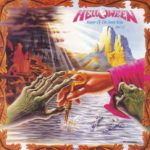 Helloween – “Eagle Fly Free” from Keeper of the Seven Keys – Part II (1988)
Helloween – “Eagle Fly Free” from Keeper of the Seven Keys – Part II (1988)
The importance of Helloween in the history of European power metal can hardly be overstated. While the debut EP and first full-length album can be regarded as Helloween’s artistic peak, it’s the prodigiously successful twin-releases Keepers of the Seven Keys Part I and II (1987 and 1988 respectively) in particular that has exerted the strongest influence on later bands. Moving away from the raw, speed metal-charged riffing of Walls of Jericho towards a more accessible, vocal-driven sound defined by infectious melodies, constant upbeat rhythms, minor verse/major chorus-modulations, straightforward song structures, high-pitched acrobatic vocals and, last but not least, characteristically “uplifting” but slowly changing chord progressions staked out by a steady stream of palm-muted 8/16-notes on the rhythm guitar(s), Keepers I & II presents a lush, affirmative and often humorous take on metal music – effectively serving as paragons for contemporary European bands as well as the second wave of power metal emerging in the mid-1990s (what we today denote as ”melodic” power metal – or flower metal by detractors).
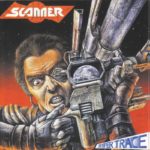 Scanner – “Terrion” from Hypertrace (1988)
Scanner – “Terrion” from Hypertrace (1988)
Following the triumphs of early power metal acts like Helloween and Running Wild, the German metal scene moved into a new phase as bands began adopting musical vocabularies similar to what we here denote as the first wave of European power metal. One example of this phenomenon was a band called Lions Breed. With the negligible Damn the Night (1985) under their belt, Lions Breed decided to morph into the more suitably christened Scanner; presumably in an attempt to join the burgeoning power metal movement.
Scanner’s first and best album Hypertrace (1988) doesn’t exactly break new ground, sounding like a blend of Walls of Jericho- and Keepers-era Helloween with a nod or two to classic German bands such as Destruction and Accept. What makes Hypertrace exceptional compared to contemporary bands working in a similar style (Grave Digger, Rage, Stormwitch, etc.) comes from Scanner’s superior songwriting skills and ability to channel their influences into a unique vision. In spite of being stylistically derivative, structurally predictable and containing copious amounts of cheese, each of these high-energy power metal anthems possesses a distinct tone and pacing which re-connects with the underlying conceptual storyline. Unfortunately, much of this is lost on the listener since the band (or record label) decided to re-arrange the songs on the record, resulting in a more commercially viable product but less rewarding musical experience.
Despite having formed way back in 1977 (as Reinforce) and releasing one of the most entertaining and all around cohesive albums within their field (and one that contains actual riffs), Scanner never received the same level of recognition as their peers and eventually faded into public oblivion after a decent follow-up album.
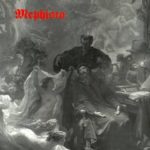 Mephisto – “Mephisto” from Mephisto (1988)
Mephisto – “Mephisto” from Mephisto (1988)
When comparing the unified style that took form in Europe to the rough and outlandish spirit of early North American power metal, the former can come across as rather timid and convention-bound. However, those who dare to look further than the established artists, can appreciate subtle nuances in a given style and have the stomach to endure a little bit of awkwardness might eventually discover that there is more to Euro-styled power metal of the late-1980s than what was initially perceived.
Without denying that heaps of poor and incredibly mediocre music were produced in the wake of the first wave of power metal, there’s at least a dozen interesting releases that for some reason or another has remained under the radar. In the case of Germany’s Mephisto the badge of obscurity doesn’t exactly come as a surprise. Their debut album Mephisto, released in a highly limited run, is a sprawling power metal-potpourri that never misses a chance to test the listener’s patience by walking the line between ridiculous and sublime.
Most ambitious is the title track; a lengthy number that transcend, often simultaneously, several stylistic boundaries (German and US power metal, NWOBHM, speed metal, neoclassical shredding and the more extravagant side of seventies rock). The short prologue, some kind of pitch-shifted incantation in German, coupled with the demonic album art may lead the unsuspecting listener into believing that he or she is up for yet another half hour of run-of-the-mill Deutsche deathrash, but procedures soon take a different turn as the song segues into a speed metal-styled riff-salad consisting of several discrete sections interlaced with dual harmonies reminiscent of the NWOBHM. Despite being built on variations of established tropes, this lengthy sequence builds momentum well, much to the credit of the attentive rhythm section.
What follows next is the first verse section proper. The underlying rhythm riff sounds like it was capped right off a mid-80s speed metal demo tape with the chainsaw-like timbre and rhythmic attack kept intact – not what would be normally expected in a post-Keepers German power metal release. What is even more baffling though is the sudden entrance of the vocalist. Reminiscent of an under-aged and heavily German-accented brother of Angel Witch’s Kevin Heybourne, his crisp voice and manner of intonation stands in stark contrast to the muscular guitars and correspondingly hard-hitting rhythm section. It’s hard not to allow a mild chuckle when hearing the song for the first time. Yet there is peculiar quality to the material as a whole, and when the verse repeats after a short contrasting section, things start to fall into place. A second wave of momentum keeps building as the band sneaks in a series of melodic fragments complemented by an understated keyboard-based sequence, eventually erupting in one of the most memorable and uplifting choruses in power metal history. The vocalist spreads his wings and leaves the earth behind altogether while the rhythm guitar keeps grinding down on the ground. An odd juxtaposition, but very effective in producing a sensation of struggling against and eventually overcoming adversity. And this is only halfway through the song…
Mephisto deserves a mention in the annals not just for their versatile and unconventional approach to style and composition within the subgenre, but also because their music throws light on the importance and inimitability of unselfconscious expression.
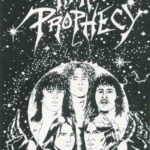 Final Prophecy – “Golgotha” from Beyond Reality (1988)
Final Prophecy – “Golgotha” from Beyond Reality (1988)
Even if power metal, both of the European and North American variety, have a long-standing practice of incorporating elements from adjacent subgenres, this willingness to expand upon a given
template seldom extends beyond the sphere of technique and surface aesthetics. For example, it is rare to find a power metal band that strays away from standard verse/chorus structures in the same way as occurred in death- or black metal. Final Prophecy is something of an exception to this rule when it comes to the early German power metal movement. Whether or not Final Prophecy were influenced by nascent death/black-metal is debatable, but the four compositions that make up their sole demo-release Beyond Reality bear more than passing similarity to the narrative-driven approach of underground metal.
Coming off as an amalgamation of early Helloween, Blind Guardian and underappreciated US speed metal act Holy Terror if filtered through the progressive songwriting of Mercyful Fate, Final Prophecy took power metal to the next level in terms of intensity and song development. The blistering dual lead interchanges, galloping rhythms and anthemic choruses remain intact, but serve a greater purpose rather than being ends in themselves. Final Prophecy allows songs to pass through several variations on main riffs, further complemented by melodic hooks that eases orientation and thematic development. Take, for example, the use of motifs in “Golgotha”. Following an introduction of main themes/riffs, the song drops into a contrasting section characterized by a rhythmic motif played in unison by bass (here mixed up for the sake of augmentation) and guitars. A series of elaborations follow, and when the vocals re-enters the motif is transformed into a fully formed counter theme that puts the preceding components of the song in a new perspective.
Beyond Reality embodies a truly epic form of power metal that thankfully avoids musical and extra-musical clichés. Songs flow seamlessly through a variety of contrasting and constantly morphing sections without neglecting the exuberant melodicism and sense of forward motion that makes power metal enjoyable on a more direct level.
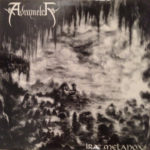 Adramelch – “Zephirus” from Irae Melanox (1988)
Adramelch – “Zephirus” from Irae Melanox (1988)
Italian power/prog-metal act Adramelch created compositionally erudite and densely atmospheric music within a style otherwise dominated by cute tricks and melodrama. Even if influences aren’t too difficult to pick out – imagine a blend of Iron Maiden, first wave German power metal and progressive USPM pioneers Fates Warning – there’s something unique about Adramelch that goes beyond stylistic signifiers.
While rough in presentation, Irae Melanox delivers in terms of horizontal and vertical complexity without derailing into technical irrelevance. Like Final Prophecy above, Adramelch favors of a more flexible compositional approach that could be likened to a more condensed and somewhat sloppier version of early-1970s progressive rock. Moreover, Irae Melanox features what could best be described as “metal-counterpoint” in the way multiple instrumental voices interact by playing separate melodic lines simultaneously, granting the music a sense of depth and heightened dynamics seldom found in power metal.
A singular conjunction of medievalist atmosphere (augmented by the archaic production), melancholy and spirit aflame, Irae Melanox offers an immersive, emotionally charged listening experience and easily counts among the most inspired and otherworldly works in power metal.
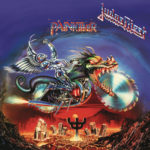 Judas Priest – “Metal Meltdown” from Painkiller (1990)
Judas Priest – “Metal Meltdown” from Painkiller (1990)
Following a period of re-vitalization with the NWOBHM-inspired Screaming for Vengeance (1982) and Defenders of the Faith (1984), Judas Priest spent the rest of the 1980s in a state of steady decline culminating in the uninspired Ram it Down (1988). While some point to the experimental glam rock of Turbo (1986) as the low-water mark in the band’s career, Ram in Down was in fact much more of a letdown in its more than obvious attempt to cater to the lowest common denominator in heavy metal music and culture. Very few could have thought the band would recover after such a cheap and misguided affair. Fortunately, Judas Priest proved the world wrong with the release of Painkiller.
While generally not associated with the subgenre here under scrutiny, Painkiller nonetheless serves as an illuminative example of power metal theory put into practice. Seemingly influenced by Slayer, Judas Priest incorporated a wide range of underground-derived techniques into their otherwise traditionally-tinged repertoire; resulting in a more intense and acerbic form of heavy metal. In hindsight, Painkiller comes across as even more of a rarity in the sense that neither Judas Priest nor anyone else have succeeded to recapture or expand upon the combustive formula that is the modus operandi of the album. A more thorough exposition of the album was written last year by DMU associate George Psalmanazar and can be found here.
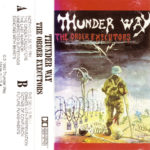 Thunder Way – “Crimes with Prepensation” from The Order Executors (1993)
Thunder Way – “Crimes with Prepensation” from The Order Executors (1993)
As the 1990s dawned it became increasingly clear that the first wave of power metal on both sides of the Atlantic was grinding to a halt. This was a time marked by intense activity in black- and death metal, whereas power metal seemed to have hit a creative dead end. Consequently, attention shifted away from power metal much in the same way that happened to speed metal at the same time. During this state of hibernation lasting up to the emergence of a second wave of power metal in the late-1990s, only a handful of established bands kept producing albums that could match their earlier output to some extent. Instead the flag passed on to decentralized areas such as South America and East Europe, where power metal still retained some of its former vigor.
Among the scattered products of this “dark age” of power metal hides a handful of unpolished gems that either by grace of musicality, creativity or in some cases eccentricity mirrors the spirit of the old garde. Albania’s Thunder Way ticks off all three of the aforementioned qualities. Despite being dated anno 1993 and recorded in a country far off the periphery, the band’s sole release The Order Executors harkens back to 1980s heavy/power metal both in style and spirit while retaining an identity of its own.
On a superficial level The Order Executors pretty much reaffirms established prejudices regarding Eastern European heavy metal: stylistically derivative music performed by skilled musicians working with relatively modest means of production. However, in contrast to the majority of bands that operated behind the Iron Curtain Thunder Way doesn’t settle with providing more or less valid imitations of their Western inspirational sources (in this case Iron Maiden and Helloween), but rather a re-interpretation of the same. Thus, Maiden-esque parallel harmonies and Teutonic palm-muted single note-picked rhythmic are subjected to a distinct melodic sensibility, performed with utter conviction and channeled into inventive song structures that more often than not eschew standard verse/chorus structure in favor of a linear progression of discrete song-sections.
While the crude production values and occasionally unorthodox compositional methods may scare away the average power metal fan, The Order Executors stand heads-high above the slick but expressively emasculated products of the current era.
Afterword
Even though the exact birth point of the subgenre remains subject to debate, few would dispute that power metal (whether it is described as a style or subgenre) came into existence at some point during the early to mid-1980s. Judging from the available data it seems very likely that the power metal movement in Europe originated on German ground where it underwent a formative stage before spreading across the continent. The first wave of European power metal has thus been described as lasting between ca 1984-1989, a period which covers both the creation of a composite style and its subsequent proliferation across the continent. If this thesis holds true, then it can be asserted that power metal developed strictly in parallel to the early stages the proto-underground/death/black-metal trajectory. Considering that both of these “strands” emerged at the onset of speed metal, one could say that power metal represents an alternate or parallel evolution within metal which has maintained close ties to heavy metal while incorporating techniques primarily associated with later developments within the genre.
One of the main reasons for highlighting developmental stages and dividing them into what might seem like an arbitrary grouping of “waves” as have been done here relates to the current state, or rather status of European power metal. When the term power metal comes up, most metal listeners will automatically associate it with music produced during the second wave, as represented by bands like Stratovarius, Rhapsody and later Blind Guardian (or even worse, Freedom Call, Edguy and Hammerfall), usually followed by a quick remark about the cheesiness or weak nature of the music at stake. Those who are aware about early (i.e. 1980s) power metal bands tend to label them as “speed metal.” Not speed metal as the term is used on the DMU, but rather “speed metal” as a vague and seldom explained subgenre that is somehow different from what people erroneously refer to as thrash metal. This is regrettable for many reasons, some of which will be touched upon in later parts in this series, but primarily because the best music produced during the first wave power metal is infinitely much more powerful and rewarding than what is currently identified as power metal.
Tags: Adramelch, death metal compilation, Europeon power metal, Final Prophecy, helloween, history of metal, Introduction to Power Metal, judas priest, Mephisto, metal academia, power metal, Running Wild, Scanner, Thunder Way


Helloween is gay
gay like a fox
Adramelch is some good shit. Will have to check out that Mephisto cause I’ve never heard it.
I may again be outing as a blockhead incapable of understanding the finer points of this or that, but I’d take something like
https://www.youtube.com/watch?v=jM656ox2waE
over Scanner everytime as it has heart and not just neon-coloured plastic (were I still listening to this kind of music, that is).
Also,
https://www.youtube.com/watch?v=yzCxz3jF7yE
at about 22:44.
No real point listening to this online in a digitized version. The sound cries for playing the LP on a stereo at some insane volume, with the lower frequencies causing actual vibrations.
Classic compilation
That’s interesting because Rage always struck me as incredibly bland. To each their own, I guess.
It’s probably difficult/ impossible to understand this without knowing the book (Hans Bemman, Stein und Floete, not suitable for big babie^W^Wmasculine tithangers).
I’m not so good at putting these things into words. Because of this, I’ll restrict myself to a very short and simple bit of another Rage track, namely, the chorus of
https://www.youtube.com/watch?v=m1EKiEgdXwk
It helps to try to sing this a couple of times in order to get an idea of its shape. This is a step-by-step melody where each syllable has its own note, something which resembles so-called 19th century (German) art songs (Kunstlied). It starts with the overblown “Everybody says: You must buy this!” enthusiasm of the commercials it caricatures and progresses towards the conslusion with its “This is really worthless junk. They’re just programming your mind” undertone. The second line has the same pattern but in a slightly modified way which puts more emphasis on the message the wording now conveys in a slightly less camouflaged way. That’s a good starting point to explore this track which is built from variations/ reflections of the chorus theme (too simplified) changing in line with lyrics in a very deliberate and delicate way contrasting the overly crass “Kai Hansenisms[*]” of the vocal tone (another stylistic device).
This is really an exercise in “Have we fooled you into disregard? Good! You meant to open the next door, anyway.”
[*] I can tolerate Dickinson and sometimes, even Halford, but Kai Hansen — no way.
Hmm, interesting interpretation, thanks for sharing
As the previous commenter wrote: interesting observation. Haven’t given Perfect Man a chance since… I don’t know, but your comment made me want to revisit.
Listen to power metal, get a boner, then put it in a woman.
Blind Guardian fucking kills
Personally I really do think speed metal is an actual thing. However the classic problem with the genre is that quite often an album would have only a couple songs that are speed metal with the rest of the album being something else. Classic example is the full on speed metal assault that is “Fast as a Shark”, of course as we all know that it is not only the only song in that style on the record but in their entire career. Thrash and speed metal would become intertwined in the US. Albums like Rust in Peace being a good example of how the genres became intertwined there. Lots of speed metal on that album and definitely distinct from pure American styled “thrash” like with Sacred Reich. In Europe however of course speed metal became more melodic and eventually the guitar playing in general morphed into what we call EUPM as you explain quite well in this article.
However this does not mean that speed metal does not exist. This is becoming more evident today with not only people rediscovering obscure gems such as Acid but also the emergence of new bands that play something that we can only describe as speed metal like with Evil Invaders or Ranger. https://www.youtube.com/watch?v=FZZZCWPwGak
I can’t fully explain why Agent Steel’s main riff is pure speed metal because I am just a guy who learned to play guitar by himself. However I can definitely take that riff and turn it into a thrash metal riff quite easily. Essentially punking it up rhythmically (I think thats what I do)
As for something not really related. One thing I find very interesting with Running Wild is that they are a bit of an outlier in a few ways when compared to the rest of that scene. To be specific I think Running Wild foreshadows black metal. This becomes especially obvious with the riff in Calico Jack that starts here: https://youtu.be/J_3KVrzcxEI?t=43
We got in essence a riff that basically starts as a 2nd wave Norwegian black metal riff but it resolves in a more classic speed metal fashion.